List of content you will read in this article:
- 1. What is a Domain Name? [Definition - Domain Name Meaning]
- 2. History of Domain Name
- 3. What is DNS? [Domain Name System]
- 4. Difference Between DNS and Domain Names
- 5. Types of Domains
- 6. What are TLDs? [Definition - A Beginner's Guide]
- 7. Difference between Web Hosting and Domain
- 8. The Domain Contract
- 9. Waiting Time for Domain Names
- 10. Difference Between Network Domains and Domain Names
- 11. What are Professional emails?
- 12. Conclusion
When you want to access a website on the internet, you simply type the name of the website in the search bar of your browser. For example, if you want to reach Monovm.com, then you are entering the name of the site i.e monovm.com, and press enter button, then the website will be shown on your browser.
This all is possible because of the domain name, without them, you would have to remember the complex number [IP address] as a human, which is very difficult to understand or remember. to solve this problem and to make it human friendly there is a term called domain name that is simply equivalent to the IP address of your website.
So let's move to understand the concept of a domain name, how does it works, why it is important for users,s, and the Types of domains you can avail use for your business by checking with the various domain registrar.
What is a Domain Name? [Definition - Domain Name Meaning]
Domain names are the letter counterparts of an IP address. Every device connected to the internet has a unique IP address assigned to it, which is used by others to send and receive data. A domain name can represent a single or multiple IP address.
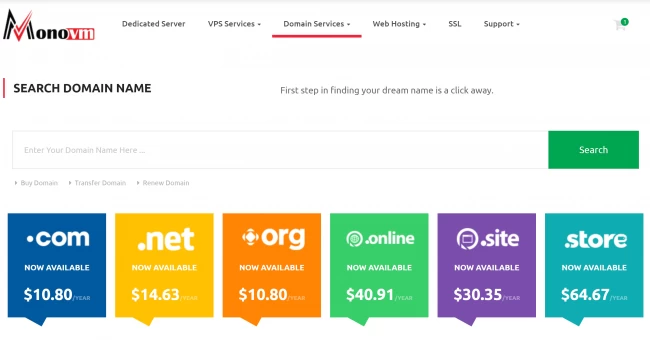
For example, Monovm’s IP address is 104.20.20.40, However, it would be difficult for a person to remember it, so instead of remembering the IP address, you can type our domain name, which is monovm.com, in order to open our website.
Domain names are also beneficial for your audience/visitor to identify your website on the internet. Apart from it, they can use the domain name to visit the website directly. Hence it is good to have an easy domain name as it helps visitors to find easily the website. The difficult domain name can easily impact your website's traffic and visibility because it will become hard for visitors to find over the internet. Now let's have a brief description of the history behind the domain name.
History of Domain Name
Let us start from the very beginning, In October 1984, 6 generic "top-level domains" (gTLDs, including .com, .net, .org, and .gov) were established to provide domain space for corporations, non-profits, schools, networks, US government offices, and the US military.
On March 15, 1985, Symbolics Inc., a computer manufacturer in Massachusetts, registered the domain name Symbolics.com, making it the first appropriately registered .com domain in the world. From that point on, until 1995, domain registration was free of charge. That all changed when the National Science Foundation awarded tech consulting company Network Solutions the ability to charge for registration. Domain prices began at $100 for a two-year registration.
In the year 1998, the Department of Commerce proposed privatizing the DNS (i.e., Domain Name System), which was, at the time, under the control of the United States government. This eventually led to the formation of ICANN (i.e., Internet Corporation for Assigned Names and Numbers).
Due to some controversial domain naming practices, in 2003, the Truth in Domain Names Act was incorporated into the PROTECT Act, setting a punishment for the creators of misleading domain names.
By December of 2013, the internet had officially run out of all the possible four-letter combinations for the .com TLD (i.e., Top-Level Domain). All 456,976 possible combinations from AAAA.com to ZZZZ.com have been exhausted.
In 2014, more than 100 new generic TLDs were added to the registration list, allowing for even more possibilities of website naming. The most expensive domain name sale was carried out in 2007 for the low price of $35 million. The domain was VacationRentals.com, and the buyer purchased it for the purpose of keeping it out of the hands of his competition.
What is DNS? [Domain Name System]
In simple words, the Domain Name System is the phonebook of the internet. Although web browsers interact via the Internet Protocol (IP) addresses, they are just a bunch of numbers (and letters in the case of IPv6) that would be difficult for a human to memorize. Instead, it is much easier for us to remember a website name such as google.com or facebook.com.
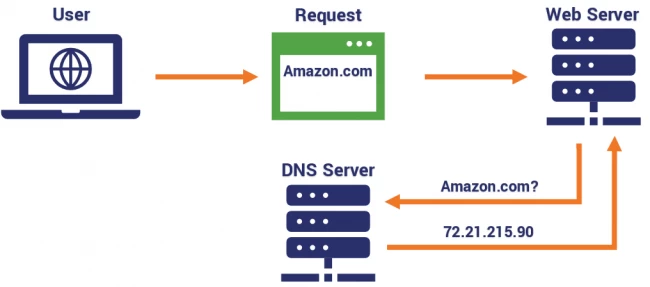
Each device connected to the internet has a unique IP address that other machines use to find the device. DNS converts easily memorable website names into computer-readable IP addresses and vice versa. This eliminates the need to remember complex IP addresses such as 192.168.1.1
Difference Between DNS and Domain Names
Now we know what domain names are and the DNS, let us explain the difference between them.
The domain name of a website is simply a string of characters such as monovm.com that helps users identify the website.
On the other hand DNS is the system that converts a website's domain name to its IP address using purposefully-built DNS servers when requested to do so by a user.
Types of Domains
When people think of a website, the standard ".com" pops into their minds, It is the most common type of extension available for use but People also use various other types of Domains for their business uses, Here we have listed or categorised them in five types of domains, and they are:
- Top-Level Domains (TLDs)
- Country-Code Top-Level Domains (ccTLDs)
- Generic Top-Level Domains (gTLDs)
- Second-Level Domains (SLDs)
- Third-Level Domains (Subdomains)
If you want more detailed information about each type of domain, check out our blog post on Different Types of Domains.
What are TLDs? [Definition - A Beginner's Guide]
The description for TLDs can be quite simple: They are the suffix that comes after the Second-Level Domain within a web address. For example, in www.monovm.com, the Top-Level Domain is .com, while in www.wikipedia.org, .org is the TLD.
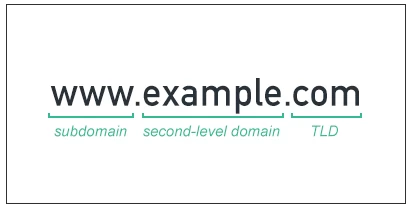
The Internet Assigned Numbers Authority (i.e., IANA) released six top-level domains in the 1990s. These became known as domain name extensions and represented the highest level in the Domain Name System hierarchy, and they are:
- .com was the first TLD to be available for common use. So it stands for commercial and was initially made to be used by commercial organizations. Regardless, it soon became the most commonly used domain that was especially popular among businesses, websites, and emails.
- .net Short for network, it was created for use by institutes that took part in network technologies like infrastructure companies and internet service providers. Nevertheless, the restrictions that were meant to limit if for networking purposes were not upheld, and just like the .com TLD, it became one of the most popular top-level domains, coming in a close second to .com.
- .edu was created for use by educational institutions worldwide, and it only gained popularity in the United States. Schools and universities in other countries opted to use it together with their country-level domains such as .edu.au for Australia and .edu.de for Germany, etc.
- .org is shortened from the word organization and was designed to be used by non-profit organizations. Similar to the above-mentioned TLDs, restrictions for it were not enforced, and it soon was being used for both non-profits and profit businesses alike, as well as schools and communities.
- .mil Shortened for the military, it was made for United States military branches, and unlike the previously mentioned TLDs, restrictions were followed and are upheld to this day. Only official US military websites have access to use this top-level domain.
- .gov This being the shortened version of “government”, just like .mil, its restrictions were strictly upheld, making this TLD available only to govern governmental agencies, programs, cities, states, towns, and counties. These became what is nowadays known as generic Top-Level Domains (gTLDs), and hundreds more were added to this list.
Nowadays, all the above-listed domain extensions are known as generic Top-Level Domains (gTLDs), and hundreds more were added to this list.
Difference between Web Hosting and Domain
If you wish to have your site up on the internet, having both a web host and a domain name registrar is necessary. Without web hosting, you will not have a server to put your site on, and without a domain name registrar, people would not be able to reach your site.
Many web hosting service providers offer both web hosting and domain name registration services which monovm also offer. However, not all do so. Some are simply providing servers without registering a domain name and vice versa.
The good news is that web hosting service providers offer special discounts on domain registration When you purchase both the services i.e. Webhosting and Domain name registration from them.
However, keep in mind that these discounted prices are only in effect for one or two years, after which the registrar will bill you for the annual or biennial fee. In other words, the domain provider of the discounted domain name pays only for the first billing from the registrar.
The Domain Contract
When buying something, we usually think that what are the thing which domain service providers keep forever, but it is not true in many cases. It includes registering domain names as well. First and foremost, when you purchase a domain name, it is more of a lease, as after you stop paying for it, it no longer belongs to you and is available for others to buy.
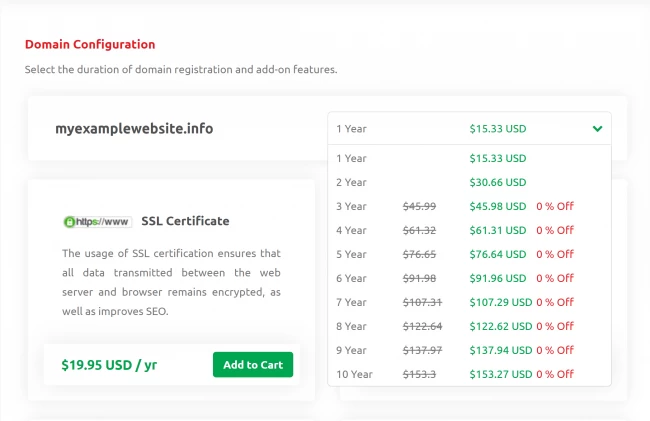
Many domain registrars also have the right to revoke your domain name for certain reasons. The most common include using your domain name for illegal purposes or carrying out behaviour that is deemed unacceptable, such as spamming.
We urge you to read your domain contracts carefully as many of them include clauses that allow registrars to terminate these contracts for no apparent reason at all, as well as allow registrars to make changes to the registration agreement whenever they want without prior notification.
Once you select the registrar you want to register your domain with, you can choose a longer billing period for your contract, which often given you a discount on the service's price, sometimes very significantly.
Waiting Time for Domain Names
Despite the current focus on automation and efficiency, a domain name won't be available for use straight away after the purchase is complete. It might take anywhere from a few hours to several days for a domain to be propagated. This means that the domain name registry must first be updated with your website's DNS information before it could be put to use.
Although some registrars promise to have your domain name registration instantly, the actual waiting time might take seven business days not more than this. Such a long wait period is typically not the case, and usually, domain names are up and running on the internet within two days, however, do not be alarmed if it takes longer.
Difference Between Network Domains and Domain Names
Now, this is one area where newcomers to the computer and networking world often get mixed up. In the context of networking, a domain refers to any group of users, workstations, devices, printers, computers, and database servers that share different types of data via network resources and are known as Network Domains
However, when put into the context of web hosting, a domain name is simply the identifiable string for a website that replaces the site's IP address within the address bar when a user wishes to connect to it.
What are Professional emails?
Here's a small bonus you get when registering a domain name with a respectable registrar. They also provide a professional email that you can use based on the domain name also sometime they are giving you a discount like 1 free professional email for one domain.
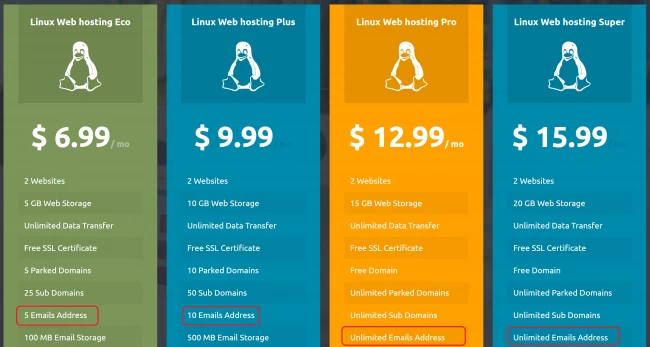
Usually, it is only a few emails that you get for free, and if you want more, you will have to purchase extra ones by paying a monthly subscription amount. For example, you are registering exampledomain.com. You can then create emails such as management@exampledomain.com and support@exampledomain.com. These emails look much more professional than, let's say, management_exampledomain@gmail.com or support_exampledomain@gmail.com.
Conclusion
Throughout this article, we went through all the details about what is a Domain name, Domain Name Meaning, Types of Domains and Other important facts, Also Lot of thinngs has changed since the 1980s to till now. With the development of the internet, the domains have substantially grown.
There are hundreds of new TLDs available nowadays, from .photography to .kitchen. There are many options to choose from if you are planning on getting a domain name. The biggest hurdle when choosing a domain is to pick the right name. Not to worry because we have the perfect guide with tips on how to choose the perfect domain.
If you feel we have missed any points which we should add to this article, then please comment in the below-given comment section.
Subscribe to our newsletter to update it with hosting, domain, SSL and VPS-related knowledge-based tutorials and special offers.
![What is a Domain Name? Domain Name Meaning? [Tutorial]](/wp-content/uploads/2020/11/what is domain185-main.webp)